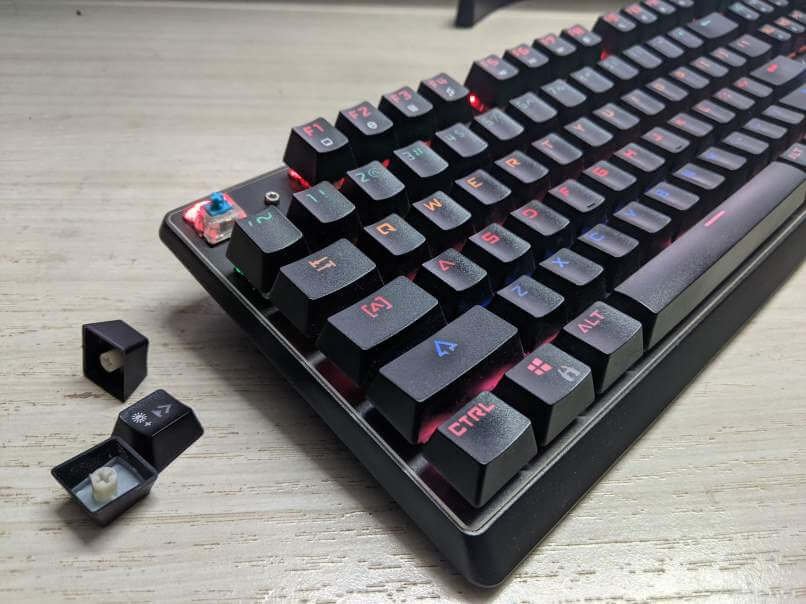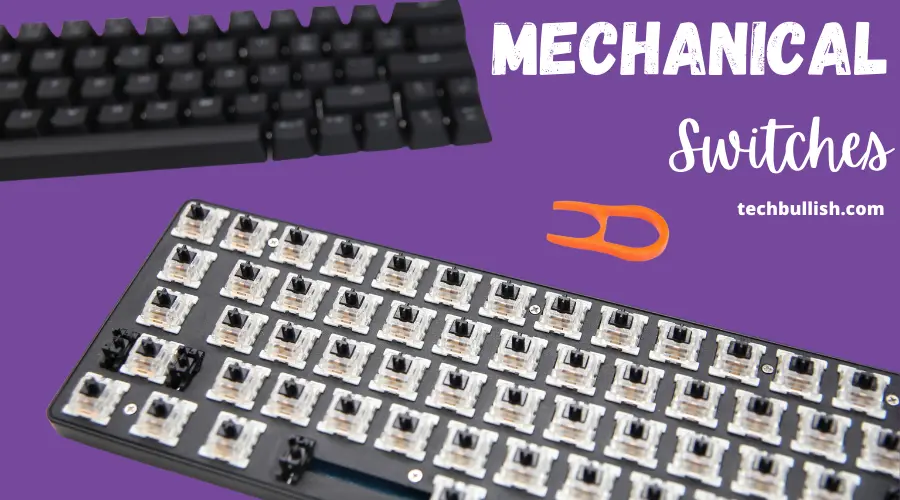Tired of typing on unresponsive keyboards? Mechanical keyboards offer a superior experience with physical switches beneath each keycap.
Learn how they work and why you need them!

Key Takeaways
- Mechanical keyboards use individual switches for each key, which are more durable and responsive than membrane keyboard switches.
- Mechanical keyboards offer a variety of switch types to suit different preferences, including tactile, linear, and clicky switches.
- Mechanical keyboards have several advantages over membrane keyboards, including durability, tactile feedback, customization, N-key rollover, and typing sound.
How Do Mechanical Keyboards Work?
Mechanical Keyboard keys have individual switches mapped to them below. On the top layer, there are Keycaps.
Below the Keycaps, lie the Mechanical Switches. Below the mechanical switches lie the PCB board which receives the input signal.
Here is the mechanism of how mechanical keyboards internally work:
- First, we press the keycap which lies on the top of the mechanical keyboard. It actuates the mechanical switch below it.
- On applying pressure from the keycap, the mechanical switch gets pressed. However, it requires a certain amount of force to actuate known as actuation force due to the presence of a metal spring within the switch that causes stiffness to be present.
- The spring compresses the mechanical switch’s stem goes down, and finally, the metal contacts touch the PCB completing the circuit.
- This now sends a signal to the computer that a click has been noted.
In contrast to a rubber dome keyboard, mechanical keyboards are preferred by gamers as their gaming keyboard choice due to their high-quality mechanical switches in them.

Also, they have N Key Rollover which helps to input multiple characters all at once accurately which is only possible in the case of a mechanical keyboard due to the individual switch design and not array-based keyboard input.
Mechanical keyboards offer different switch types to suit different preferences. Some keyboards offer tactile, linear, or clicky switches.
Clicky switches produce loud clicking noises and are ideal for those who like typing loudly.
How do Mechanical Keyboard Switches work?

Mechanical switches have a metal spring within them which creates stiffness and requires force to actuate them.
On pressing a mechanical switch, the spring gets compressed and the switch stem presses the keyboard PCB and completes the circuit.
This is how a keystroke gets registered by a mechanical switch.
Now, during pressing the mechanical switch, it gets through two positions which are an actuation point and a reset point.
The actuation point represents the position at which the switch registers a keypress, and the reset point represents the point at which the switch no longer registers a keypress.
Switches vary in resistance and can be classified according to the type of switch they are. Some switches are clicky while others are tactile.
Each type of switch is classified by its color, and each color has a different tactile bump or audible click when it is pressed.
Types of Switches for Mechanical Keyboards
There are three mechanical keyboard switch types which are: clicky switches, linear switches, and tactile switches.
1. Clicky Switch: Keyboards would give you a clicky feel while you are typing but they are loud.
E.g., A Cherry MX Blue Switch Keyboard.
2. Linear switches: They lack a tactile bump but provide consistent snappy actuation from the key switch of your mechanical gaming keyboard.
E.g., a Cherry MX Red Linear Switch keyboard or a Cherry MX Speed Silver switch keyboard.
3. Tactile switch: keyboards don’t make much sound but have good bumpy feedback in them.
E.g., Cherry MX Brown Mechanical Switch Keyboard.
There are other manufacturers other than Cherry MX like Gateron, Kailh, Outemu, etc. You will also find clones of a Cherry MX switch which comes cheaper but does not last long.
So, find the keyboard switch type you want and then choose from the wide range of switches these manufacturers provide.
Advantages of Using a Mechanical Keyboard over a Membrane Keyboard
There are several advantages of using a mechanical keyboard over a membrane keyboard:
- Durability: Mechanical keyboards are more durable than membrane keyboards. The keys are built to withstand millions of keystrokes, which means they are less likely to break or wear out over time.
- Tactile Feedback: Mechanical keyboards provide tactile feedback, which means you can feel when a key has been pressed. This can help improve typing accuracy and speed.
- Customization: Mechanical keyboards often come with customizable keycaps, which means you can change the look and feel of your keyboard to suit your preferences.
- N-Key Rollover: Mechanical keyboards often have a feature called N-key rollover, which means you can press multiple keys at the same time without any of them being missed. This is especially useful for gamers who need to press multiple keys simultaneously.
- Typing Sound: Some people prefer the sound of a mechanical keyboard when typing. The sound can be satisfying and can also provide auditory feedback when typing.
Overall, mechanical keyboards offer several advantages over membrane keyboards, including durability, tactile feedback, customization, N-key rollover, and typing sound.
Benefits of Mechanical Keyboards

There are many benefits to a mechanical switch keyboard. If you spend a lot of time typing on a computer, you will love mechanical keyboards.
The key switches in a mechanical keyboard are highly responsive. They produce a clicky sound halfway through their travel.
This helps users type more accurately and comfortably. A mechanical keyboard will last up to 10 to 15 years on moderate usage. Typically, you’ll start with one switch type as you need to find the right type of switch as per your requirement.
Cherry Switches are one of the most popular mechanical keyboard switches. Then you need to look into the keycap material of the mechanical keyboard. If it has PBT keycaps, then it is great.
Also, check the comparison of ABS vs PBT keycaps to know why PBT is great.
Durability
A mechanical keyboard has independent switches for each key, which prevents multiple key registrations from degrading feedback.
Additionally, mechanical keyboards are customizable, and you can even customize your keycaps and choose from any type of keycap profile. You can even use custom-designed Keycaps known as Artisan Keycaps.
Pro programmers and hardcore gamers enjoy the tactile feedback a mechanical keyboard provides.
Not only does this improve typing accuracy, but it can also increase your level of satisfaction.
So, if you’re planning on buying a new keyboard, think about getting one with a mechanical keyboard.
Generally speaking, mechanical keyboards are more durable than their membrane counterparts. Their build structure and individual switches are more durable.
In addition, mechanical keyboards feature individual switches mounted underneath each key. Because mechanical keyboards use independent switches, they can last between 50 and 100 million keystrokes.
So, if you are looking to get a good-quality keyboard that will last for years to come, a mechanical keyboard is the way to go.
Better Responsiveness and Click Accuracy
Mechanical switch keyboards have different key switches in them. The rubber-dome ones are very similar to the mechanical ones, but they offer little tactile feedback.
Mechanical keyboards are much more responsive, and the different key switches give you different levels of feedback.
Mechanical switches that are tactile and clicky give awesome tactile feedback if you use them as a switch choice for your keyboard.
These are a great choice to consider for your regular usage if you like the bumpy feedback of the mechanical switches.
They are far better and more enjoyable than a membrane switch keyboard.
Easy on Hands
A mechanical keyboard is designed to minimize the impact on your fingers by reducing the amount of sideways movement you make while typing.
Traditional keyboards require a large “activation force” for every key press, which causes your fingers to “bottom out” before the key registers, increasing the strain and impact on your fingers and wrists.

I’m Anirban Saha, Founder & Editor of TechBullish. With a B.Tech in Electronics and Communication Engineering, and 6+ years of experience as a software developer, I have expertise in electronics, software development, gadgets, and computer peripherals. I love sharing my knowledge through informational articles, how-to guides, and troubleshooting tips for Peripherals, Smart TVs, Streaming Solutions, and more here. Check Anirban’s Crunchbase Profile here.
